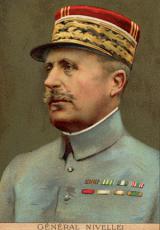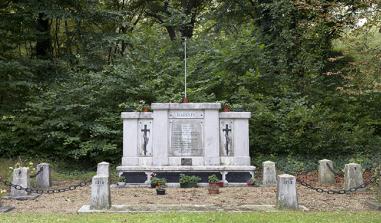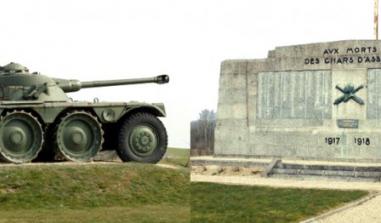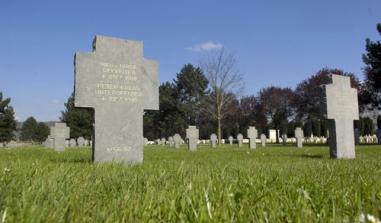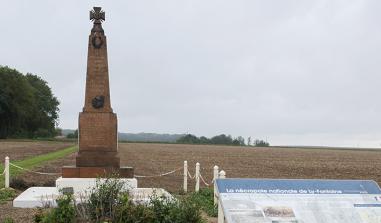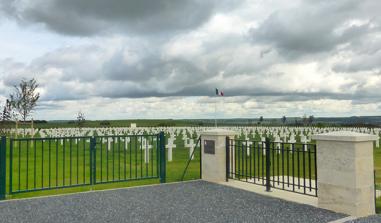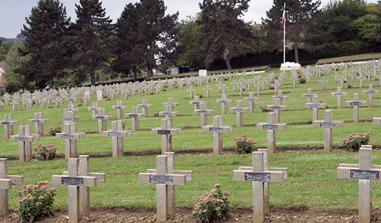Cerny-en-Laonnois – Cemeteries and chapel
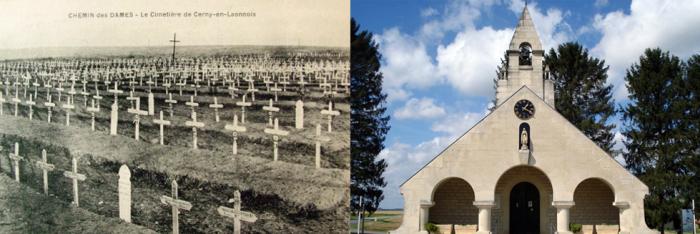
Postcard. (c) General inventory – Chapel. Source: http://dictionnaireduchemindesdames.blogspot.fr
The first battles along the Chemin des Dames stretch of road took place near a former sugar factory fortified by German troops.
The village of Cerny-en-Loannois, in the Department of Aisne, is set on a terrace overlooking the Ailette at the crossroads of the Laon-Fismes road and the Chemin des Dames.
Traditionally, the village was considered the birthplace of Saint Rémi (437-533), the bishop of Reims who baptised Clovis. It was also here that Napoleon I stayed on the evening of the Battle of Craonne on 7th March 1814. The first battles along Chemin des Dames took place around a former sugar factory fortified by the German troops.
The Colonne des Britanniques (British Column)
This baetylus is an homage to the heros of the 1st Battalion Loyal North Lancashire killed during the first battle of the Chemin des Dames: the attack on a sugar factory in Cergy-en-Laonnois in 1914.
The stone stands on the edge of B-road RD 967 and bears the inscription: "In memory of the officers warrant and non commissioned officers and men of the Battalion Loyal North Lancashire regiment who laid down their lives on active service 1914-1919 ".
At the start of the war, General Joffre launched an offensive that, from 5 September 1914, allowed the French and British troops to reach Aisne, between Venizel and Berry-au-Bac on 13 September. But the French-British advance was stopped on 14 September. On that day, the British set about digging the first trenches on the southern slopes of the Chemin des Dames, between Vendresse and the Cergy-en-Loannois sugar factory. Between 15 and 20 September, both armies sought in vain to penetrate the opposite front between Cergy-en-Loannois and Craonne. The Germans made further attempts between 26 and 29 September, echoed by the French on 30 September and then from 12 to 14 October. In early 1915, the Kaiser’s troops successfully conquered the area of the Chemin des Dames notably by attacking a farm in La Creute (the Dragon’s Cave) and started to fortify this line now behind the front line.
General Nivelle launched a huge offensive to break German lines in April 1917. A pointless effort and costly in terms of lives, it resulted in increasing mutiny amongst the troops. On 15 May, Nivelle was replaced by Pétain at the head of the French armies. From the summer, he led a series of limited attacks in a bid to regain control of strategic points as far as Ailette. In May 1918, the German command launched Operation Blücher to win back their position between Aisne and Ailette. Overwhelmed by the counter-offensive of the second Battle of the Marne, the Germans retreated in October.
The chapel
This building, officially opened on 22 April 1951, is a non-denominational memorial for Chemin des Dames. It came into being on the initiative of a committee whose honorary members included veteran officers, dignitaries from the Catholic church, the President of the Protestant Federation of France and the Chief Rabbi of France. Regimentary and individual plaques adorn the walls.
Each year in April or May, a large religious and military ceremony is organised as part of the commemorations for the battles in 1917.
A lantern for the dead
Facing the chapel, this building and its light calls to mind the sacrifice made by a whole age bracket of men to defend its values in the trenches.
French National Cemetery
Set facing the Chemin des Dames Memorial, on the edge of the Departmental Road No. 18, this cemetery covering an area of 13,515 m² shelters 5,150 bodies, 2,386 of which are in ossuaries. The cemetery also contains the remains of 54 Russian soldiers, buried after fighting on the plateaux of Vauclerc, Vendresse and Troyon and those buried on land in the villages of Beaulne, Paissy, Braye-en-Laonnois and Moulins. The cemetery was created in 1919 but was not completed until 1925. It was completely renovated in 1972.
The German Cemetery
The German cemetery in Cerny-en-Laonnois is located at the edge of the Departmental Road No. 18, to the right of the entrance into the village, if you are coming from Soissons. The site contains the bodies of 5,125 German soldiers who fell in the Chemin des Dames area. The first graves date from 1924-25, applying the clauses in the Treaty of Versailles concerning burial places.
Here lay soldiers who fought in autumn 1914, spring 1915, April/May 1917 and May, and September and October 1918. The regiments gathered here came from Westphalia, Brandeburg, Saxe, Württemberg, Schleswig-Holstein and Western Prussia.
An agreement in 1926, which came into force in 1928, endowed the cemetery with durable funerary masonry, completed by the Franco-German agreement on burial places of 19th July 1966. A general renovation was carried out in 1974. The cemetery was enlarged to make room for new tombs, a new entrance was built and all the funerary insignia was fully replaced.
Currently the site shelters the remains of 7,526 bodies. Of the 3,533 individual graves, including 12 graves of persons of Jewish denomination, 46 remain anonymous and in the ossuary that groups together 3,993 soldiers, 3,080 of them could not be identified.
Information Volksbund Deutsche Kriegsgräberfürsorge Bundesgeschäftsstelle, Abteilung Gräbernachweis, Werner-Hilpert-Straße 2, D-34112 Kassel.Tel: 0561-7009-0
A stele to the 38th African Infantry Division
Erected facing the memorial to the Chemin des Dames, this stele pays tribute to the men of the 38th African Infantry Division who fought in the Chemin des Dames and bears the following inscription: "The 38th Infantry Division, grouping the RICM (Colonial Infantry Regiment of Morocco), 4th Zouaves, 4th Mixed Zouaves skirmishers, 8th Tunisian Skirmishers, 32nd RAC (Régiment Artillerie Campagne, Country Artillery Regiment) Companies of Engineers 19/2 – 19-52, fought in September 1914 – Chemin des Dames – Craonne – Hurtebise, in April 1917 – Cerny – Les Bovettes – Heurtebise in October 1917 – Chavignon – Carrières Bohéry – Recapture of Malmaison Fort on 23rd October”.
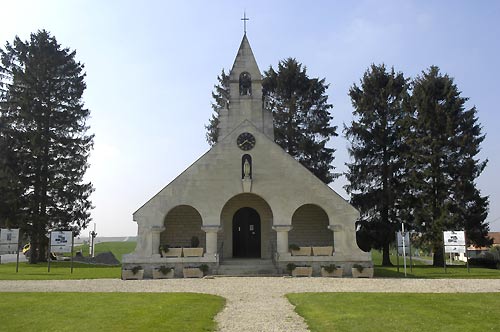
Gedächtniskapelle von Cerny-en-Laonnois. Quelle: SGA/DMPA - JP le Padellec
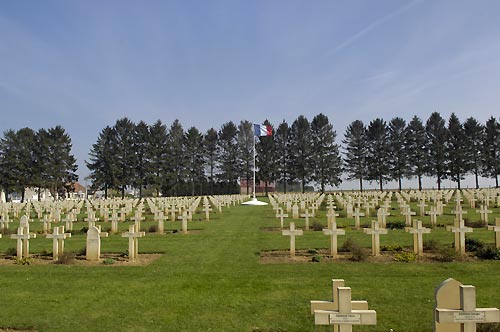
Nationaler französischer Soldatenfriedhof. Quelle: SGA/DMPA - JP le Padellec
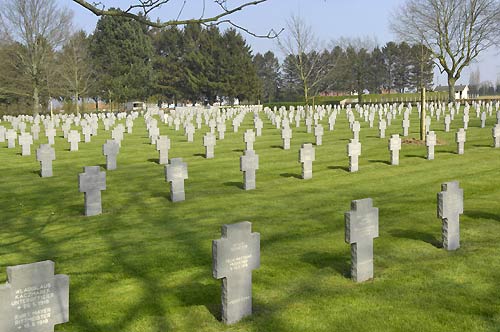
Deutscher Soldatenfriedhof. Quelle: SGA/DMPA - JP le Padellec
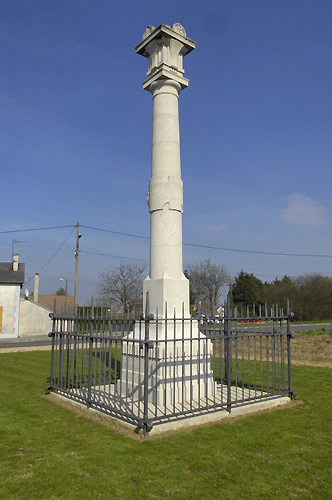
Säule der Briten. Quelle: JP le Padellec
Practical information
2860
Cerny-en-Laonnois



